Projecting Hydroclimatic Extremes: Climate Change Impacts on Drought in a German Low Mountain Range Catchment
Abstract
1. Introduction
2. Research in the Gersprenz Catchment and Its Contextualization
3. Methods
3.1. Climate Change Projections and Analyses
3.2. Drought Indices
3.3. Climatic Water Balance
4. Results
4.1. Temperature and Precipitation
4.2. Hot and Dry Days
4.3. Drought Indices
4.4. Climatic Water Balance
5. Discussion
5.1. Temperature and Precipitation
5.2. Hot and Dry Days
5.3. Drought Indices
5.4. Climatic Water Balance
5.5. Uncertainties
6. Summary and Conclusions
- Regional impact: The projected maximum warming in the Gersprenz catchment under the RCP8.5 scenario exceeds the German average by 0.8 °C. With 44 heat days per year in the far future of the RCP8.5 scenario, the study area is in the upper range of the German-wide average projections;
- Water scarcity: Despite wetter winters, long-term water deficits are expected to persist in the catchment. The study highlights that increased precipitation during winter months will be insufficient to offset the growing water deficits, exacerbating water availability challenges in the long term;
- Seasonality: In the far future of the RCP8.5 scenario, there will be about seven times more hot days and six times longer heat spells in spring and about four times more hot days and three times more heat spells in summer. The number of dry days will on average increase by maximum of 22% compared to the reference period. The maximum length of dry periods will increase by 31%;
- Autumn droughts: Climate change is projected to amplify the risk of extreme droughts in autumn, once more emphasizing the seasonal impact of changing climatic conditions. In the far future, the length of dry periods in autumn is projected to increase by approximately 68%, accompanied by an average of 18 times more hot days and 22 times longer heat periods;
- Scenario differences: Under both RCP8.5 and RCP2.6 scenarios, the magnitude and frequency of droughts increases in the future, with a more severe increase in the RCP8.5 scenario. While short-term meteorological droughts increase at about the same rate in both scenarios, long-term droughts are significantly exacerbated in the high-emission scenario;
- Water availability challenges: The study emphasizes potential issues with water availability in the region. Particularly in summer and autumn of the far future, the climatic water balance indicates substantial deficits.
Author Contributions
Funding
Institutional Review Board Statement
Informed Consent Statement
Data Availability Statement
Acknowledgments
Conflicts of Interest
References
- IPCC. Climate Change 2022: Mitigation of Climate Change. Contribution of Working Group III to the Sixth Assessment Report of the Intergovernmental Panel on Climate Change; Cambridge University Press: Cambridge, UK; New York, NY, USA, 2022. [Google Scholar]
- Arnone, E.; Cucchi, M.; Gesso, S.D.; Petitta, M.; Calmanti, S. Droughts Prediction: A Methodology Based on Climate Seasonal Forecasts. Water Resour. Manag. 2020, 34, 4313–4328. [Google Scholar] [CrossRef]
- LfU. Bayrisches Landesamt für Umwelt: Das Bayerische Klimaprojektionsensemble Audit und Ensemblebildung; LfU: Augsburg, Germany, 2020. [Google Scholar]
- Christensen, J.; Hewitson, B.; Busuioc, A.; Chen, A.; Gao, X.; Held, I.; Jones, R.; Kolli, R.K.; Kwon, W.T.; Laprise, R.; et al. Regional Climate Projections. In Climate Change 2007: The Physical Science Basis. Contribution of Working Group I to the Fourth Assessment Report of the Intergovernmental Panel on Climate Change; Cambridge University Press: Cambridge, UK; New York, NY, USA, 2007. [Google Scholar]
- Eckstein, D.; Künzel, V.; Schäfer, L.; Winge, M. Global Climate Risk Index 2020 Who Suffers Most from Extreme Weather Events? Weather-Related Loss Events in 2018 and 1999 to 2018; Germanwatch eV: Bonn, Germany, 2019. [Google Scholar]
- Ihinegbu, C.; Ogunwumi, T. Multi-criteria modelling of drought: A study of Brandenburg Federal State, Germany. Model. Earth Syst. Environ. 2022, 8, 2035–2049. [Google Scholar] [CrossRef]
- KLIWA, Klimaveränderung und Wasserwirtschaft. Niedrigwasser in Süddeutschland. Analysen, Szenarien und Handlungsempfehlungen. In KLIWA-Berichte, Heft 23; Landesanstalt für Umwelt BadenWürttemberg (LUBW), Bayerisches Landesamt für Umwelt (BLfU); Landesamt für Umwelt Rheinland-Pfalz (LfU): Mainz, Germany, 2018. [Google Scholar]
- Huang, S.; Krysanova, V.; Hattermann, F. Projections of climate change impacts on floods and droughts in Germany using an ensemble of climate change scenarios. Reg. Environ. Chang. 2015, 15, 461–473. [Google Scholar] [CrossRef]
- Roers, M.; Wechsung, F. Reassessing the climate impact on the water balance of the Elbe River basin. Hydrol. Wasserbewirtsch. 2015, 59, 109–119. [Google Scholar] [CrossRef]
- Grosser, P.; Schmalz, B. Low Flow and Drought in a German Low Mountain Range Basin. Water 2021, 13, 316. [Google Scholar] [CrossRef]
- Diller, C.; Hebecker, J. Klimawandel in Deutschland: Handlungsmöglichkeiten der Regionalplanung. Angew. Geogr. 2008, 32, 62–70. [Google Scholar] [CrossRef]
- David, A.; Schmalz, B. A Systematic Analysis of the Interaction between Rain-on-Grid-Simulations and Spatial Resolution in 2D Hydrodynamic Modeling. Water 2021, 13, 2346. [Google Scholar] [CrossRef]
- David, A.; Schmalz, B. Flood Hazard Analysis in Small Catchments: Comparison of Hydrological and Hydrodynamic Approaches by the Use of Direct Rainfall. J. Flood Risk Manag. 2020, 13, e12639. [Google Scholar] [CrossRef]
- Kissel, M.; Schmalz, B. Comparison of Baseflow Separation Methods in the German Low Mountain Range. Water 2020, 12, 1740. [Google Scholar] [CrossRef]
- Schmalz, B.; Kruse, M. Impact of Land Use on Stream Water Quality in the German Low Mountain Range Basin Gersprenz. Landsc. Online 2019, 72, 1–17. [Google Scholar] [CrossRef]
- Scholand, D.; Schmalz, B. Deriving the Main Cultivation Direction from Open Remote Sensing Data to Determine the Support Practice Measure Conturing. Land 2021, 10, 1279. [Google Scholar] [CrossRef]
- DWD. Deutscher Wetter Dienst. 2018. Available online: https://www.dwd.de/ref-ensemble (accessed on 23 July 2023).
- Brienen, S.; Walter, A.; Brendel, C.; Fleischer, C.; Ganske, A.; Haller, M.; Helms, M.; Höpp, S.; Jensen, C.; Jochumsen, K.; et al. Klimawandelbedingte Änderungen in Atmosphäre und Hydrosphäre. In Schlussbericht des Schwerpunktthemas Szenarienbildung (SP-101) im Themenfeld 1 des BMVI-Expertennetzwerks; Verkehr und Infrastruktur an Klimawandel und extreme Wetterereignisse anpassen; 2020; p. 157. [Google Scholar] [CrossRef]
- Brunner, M.I.; Slater, L.; Tallaksen, L.M.; Clark, M. Challenges in modeling and predicting floods and droughts: A review. Wiley Interdiscip. Rev. Water 2021, 8, e1520. [Google Scholar] [CrossRef]
- Buth, M.; Kahlenborn, W.; Savelsberg, J.; Becker, N.; Bubeck, P.; Kabisch, S.; Kind, C.; Tempel, A.; Tucci, F.; Greiving, S.; et al. Germany’s vulnerability to Climate Change—Summary. In Climate Change; Umweltbundesamt: Dessau-Roßlau, Germany, 2015. [Google Scholar]
- Kahlenborn, W.; Porst, L.; Voß, M.; Fritsch, U.; Renner, K.; Zebisch, M.; Wolf, M.; Schonthaler, K.; Schauser, I. Climate Impact and Risk Assessment 2021 for Germany—Summary. In Climate Change; Federal Environment Agency: Dessau-Roßlau, Germany, 2021. [Google Scholar]
- Crespi, A.; Renner, K.; Zebisch, M.; Schauser, I.; Leps, N.; Walter, A. Analysing spatial patterns of climate change: Climate clusters, hotspots and analogues to support climate risk assessment and communication in Germany. Clim. Serv. 2023, 30, 100373. [Google Scholar] [CrossRef]
- IPCC. Climate Change 2014: Synthesis Report. Contribution of Working Groups I, II and III to the Fifth Assessment Report of the Intergovernmental Panel on Climate Change; Core Writing Team; Pachauri, R.K., Meyer, L.A., Eds.; IPCC: Geneva, Switzerland, 2014. [Google Scholar]
- Taylor, K.E.; Stouffer, R.J.; Meehl, G.A. An Overview of CMIP5 and the Experiment Design. Bull. Am. Meteorol. Soc. 2012, 93, 485–498. [Google Scholar] [CrossRef]
- EURO-CORDEX. EURO-CORDEX Within the CORDEX Initiative. 2021. Available online: https://euro-cordex.net/060374/index.php.en (accessed on 15 October 2021).
- Hübener, H.; Bülow, K.; Fooken, C.; Früh, B.; Hoffmann, P.; Höpp, S.; Keuler, K.; Menz, C.; Mohr, V.; Radtke, K.; et al. ReKliEs-De Ergebnisbericht. ReKliEs-De 2017. [Google Scholar] [CrossRef]
- Krähenmann, S.; Walter, A.; Klippel, L. Statistische Aufbereitung von Klimaprojektionen: Downscaling und multivariate Bias-Adjustierung—Im Rahmen des BMVI-Expertennetzwerkes entwickelte Verfahren zum Postprocessing von Klimamodelldaten. In Berichte des Deutschen Wetterdienstes 254; Selbstverlag des Deutschen Wetterdienstes: Offenbach am Main, Germany, 2021. [Google Scholar]
- Krähenmann, S.; Haller, M.; Walter, A. A new combined statistical method for bias adjustment and downscaling making use of multi-variate bias adjustment and PCA-driven rescaling. Meteorol. Z. 2021, 30, 391–411. [Google Scholar] [CrossRef]
- Dalelane, C.; Früh, B.; Steger, C.; Walter, A. A Pragmatic Approach to Build a Reduced Regional Climate Projection Ensemble for Germany Using the EURO-CORDEX 8. 5 Ensemble. J. Appl. Meteorol. Climatol. 2017, 57, 477–491. [Google Scholar] [CrossRef]
- Schulzweida, U. CDO User Guide. In MPI for Meteorology; 2020. [Google Scholar]
- Kreienkamp, F.; Huebener, H.; Linke, C.; Spekat, A. Good practice for the usage of climate model simulation results—A discussion paper. Environ. Syst. Res. 2012, 1, 1–13. [Google Scholar] [CrossRef]
- WMO. Guide to climatological practices. In Technical Report; WMO-No. 100; World Meteorological Organization: Geneva, Switzerland, 2010. [Google Scholar]
- DWD. Deutscher Wetter Dienst. Wetter- und Klimalexikon. 2021. Available online: www.dwd.de/lexikon (accessed on 23 July 2023).
- Tebaldi, C.; Hayhoe, K.; Arblaster, J.M.; Meehl, G.A. Going to the extremes. An intercomparison of model-simulated historical and future changes in extreme events. Clim. Chang. 2006, 79, 185–211. [Google Scholar] [CrossRef]
- IKSR. Bestandsaufnahme zu den Niedrigwasserverhältnissen am Rhein. In Bericht Nr. 248; Internationale Kommission zum Schutz des Rheins: Koblenz, Germany, 2018. [Google Scholar]
- DWD. Dokumentation: Standardized Precipitation Index SPI. In DWD; Deutscher Wetterdienst: Offenbach, Germany, 2015. [Google Scholar]
- WMO. Standardized Precipitation Index User Guide; World Meteorological Organization: Geneva, Switzerland, 2012. [Google Scholar]
- Hargreaves, G.H.; Samani, Z.A. Reference Crop Evapotranspiration from Temperature. Appl. Eng. Agric. 1985, 1, 96–99. [Google Scholar] [CrossRef]
- Čadro, S.; Uzunović, M. How to Use: Package ‘SPEI’ for Basic Calculations. 2013. Available online: https://www.researchgate.net/publication/299971042_HOW_TO_USE_Package_%27SPEI%27_For_BASIC_CALCULATIONS (accessed on 15 June 2023). [CrossRef]
- bafg. Geoportal. 10 05 2022. Available online: https://geoportal.bafg.de/dokumente/had/214ClimaticWaterBalance.pdf (accessed on 23 July 2023).
- Bandoc, G.; Pravalie, R. Climatic water balance dyna mics over the last fivedecades in Romania’s most arid region, Dobrogea. J. Geogr. Sci. 2015, 25, 1307–1327. [Google Scholar] [CrossRef]
- DWD. Deutscher Wetter Dienst. 2023. Available online: https://www.dwd.de/DE/klimaumwelt/klimaatlas/klimaatlas_node.html (accessed on 23 July 2023).
- Martel, J.L.; Mailhot, A.; Brissette, F.; Caya, D. Role of Natural Climate Variability in the Detection of Anthropogenic Climate Change Signal for Mean and Extreme Precipitation at Local and Regional Scales. J. Clim. 2018, 31, 4241–4263. [Google Scholar] [CrossRef]
- Westra, S.; Fowler, H.J.; Evans, J.P.; Alexander, L.V.; Berg, P.; Johnson, F.; Kendon, E.J.; Lenderink, G.; Roberts, N.M. Future changes to the intensity and frequency of short-duration extreme rainfall. Rev. Geophys. 2014, 52, 522–555. [Google Scholar] [CrossRef]
- Westra, S.; Alexander, L.V.; Zwiers, F.W. Global Increasing Trends in Annual MaximumDaily Precipitation. J. Clim. 2013, 26, 3904–3918. [Google Scholar] [CrossRef]
- Huntington, T. Evidence for Intensification of the Global Water Cycle: Review and Synthesis. J. Hydrol. 2006, 319, 83–95. [Google Scholar] [CrossRef]
- Heinrich, G.; Gobiet, A. The future of dry and wet spells in Europe: A comprehensive study based on the ENSEMBLES regional climate models. Int. J. Climatol. 2012, 32, 1951–1970. [Google Scholar] [CrossRef]
- Diffenbaugh, N.S.; Singh, D.; Mankin, J.S. Unprecedented climate events: Historical changes, aspirational targets, and national commitments. Sci. Adv. 2018, 4, eaao3354. [Google Scholar] [CrossRef] [PubMed]
- Donat, M.G.; Alexander, L.V.; Yang, H.; Durre, I.; Vose, R.; Dunn, R.J.H.; Willett, K.M.; Aguilar, E.; Brunet, M.; Caesar, J.; et al. Updated analyses of temperature and precipitation extreme indices since the beginning of the twentieth century: The HadEX2 dataset. J. Geophys. Res. Atmos. 2013, 118, 2098–2118. [Google Scholar] [CrossRef]
- Meehl, G.A.; Tebaldi, C.; Nychka, D. Changes in frost days in simulations of twentyfirst century climate. Clim. Dyn. 2004, 23, 495–511. [Google Scholar] [CrossRef]
- KLIWA, Klimaveränderung und Wasserwirtschaft. Klimawandel in Süddeutschland: Veränderungen von meteorologischen und hydrologischen Kenngrößen. In Klimamonitoring im Rahmen der Kooperation KLIWA; Monitoringbericht 2021; Mainz, Augsburg, Karlsruhe: Offenbach, Germany, 2021. [Google Scholar]
- Kunz, M.; Mohr, S.; Werner, C.P.; Niederschlag, P.W. Klimawandel in Deutschland: Entwicklung, Folgen, Risiken und Perspektiven; Springer: Berlin/Heidelberg, Germany, 2017; pp. 57–66. [Google Scholar]
- Spinoni, J.; Vogt, J.V.; Naumann, G.; Barbosa, P.; Dosio, A. Will drought events become more frequent and severe in Europe? Int. J. Climatol. 2020, 38, 1718–1736. [Google Scholar] [CrossRef]
- Spinoni, J.; Naumann, G.; Vogt, J.; Dosio, A. High-resolution meteorological drought projections for Europe using a single combined indicator. Geophys. Res. Abstr. 2016, 18, EGU2016-12361. [Google Scholar]
- Grillakis, M.G. Increase in severe and extreme soil moisture droughts for Europe under climate change. Sci. Total Environ. 2019, 660, 1245–1255. [Google Scholar] [CrossRef]
- Cook, B.I.; Mankin, J.S.; Marvel, K.; Williams, A.P.; Smerdon, J.E.; Anchukaitis, K.J. Twenty-First Century Drought Projections in the CMIP6 Forcing scenarios. Earth’s Future 2020, 8, e2019EF001461. [Google Scholar] [CrossRef]
- Ruosteenoja, K.; Markkanen, T.; Venäläinen, A.; Räisänen, P.; Peltola, H. Seasonal soil moisture and drought occurrence in Europe in CMIP5 projections for the 21st century. Clim. Dyn. 2017, 50, 1177–1192. [Google Scholar] [CrossRef]
- Helmholtz Climate Initiative. Nehmen Dürre und Starkregen zu? 2022. Available online: https://www.helmholtz-klima.de/faq/nehmen-duerre-und-starkregen-zu (accessed on 17 May 2022).
- Federal Environment Agency. Monitoringbericht 2019: Zur Deutschen Anpassungsstrategie an den Klimawandel; UBA: Bonn, Germany, 2019. [Google Scholar]
- LUBW. Landesanstalt für Umwelt Baden-Württemberg. Weitere Klimaparameter: Klimatische Wasserbilanz. 2022. Available online: https://www.lubw.baden-wuerttemberg.de/klimawandel-und-anpassung/weitere-klimaparameter (accessed on 23 July 2023).
- Bradford, J.B.; Schlaepfer, D.R.; Lauenroth, W.K.; Palmquist, K.A. Robust ecological drought projections for drylands in the 21st century. Glob. Chang. Biol. 2020, 26, 3906–3919. [Google Scholar] [CrossRef] [PubMed]
- Van Vuuren, D.P.; Stehfest, E.; den Elzen, M.G.J.; Kram, T.; van Vliet, J.; Deetman, S.; Isaac, M.; Goldewijk, K.K.; Hof, A.; Beltran, A.M.; et al. RCP2.6: Exploring the possibility to keep global mean temperature increase below 2 °C. Clim. Chang. 2011, 109, 95. [Google Scholar] [CrossRef]
- Watanabe, M.; Suzuki, T.; O’ishi, R.; Komuro, Y.; Watanabe, S.; Emori, S.; Takemura, T.; Chikira, M.; Ogura, T.; Sekiguchi, M.; et al. Improved Climate Simulation by MIROC5: Mean States, Variability, and Climate Sensitivity. J. Clim. 2010, 23, 6312–6335. [Google Scholar] [CrossRef]
- Christian, J.R.; Arora, V.K.; Boer, G.J.; Curry, C.L.; Zahariev, K.; Denman, K.L.; Flato, G.M.; Lee, W.G.; Merryfield, W.J.; Roulet, N.T.; et al. The global carbon cycle in the Canadian Earth system model (CanESM1): Preindustrial control simulation. J. Geophy. Res. (Biogeosci.) 2010, 115, G03014. [Google Scholar] [CrossRef]
- IMAU. Institute for Marine and Atmospheric research Utrecht. 2022. Available online: https://www.projects.science.uu.nl/iceclimate/models/racmo-model.php (accessed on 23 July 2023).
- CLMcom. CLMcom CORDEX Data for Europe (EUR-11) Based on CCLM4-8-17 Model Simulations. 2016. Available online: http://cera-www.dkrz.de/WDCC/ui/Compact.jsp?acronym=CXEU11CLCL (accessed on 23 July 2023).
- Göttel, H. Einfluss der nichthydrostatischen Modellierung und der Niederschlagsverdriftung auf die Ergebnisse regionaler Klimamodellierung. In Berichte zur Erdsystemforschung 60; Hamburg, Germany, 2009. [Google Scholar]
- Christensen, P.; Gillingham, K.; Nordhaus, W. Uncertainty in forecasts of long-run economic growth. Econ. Sci. 2018, 115, 5409–5414. [Google Scholar] [CrossRef] [PubMed]
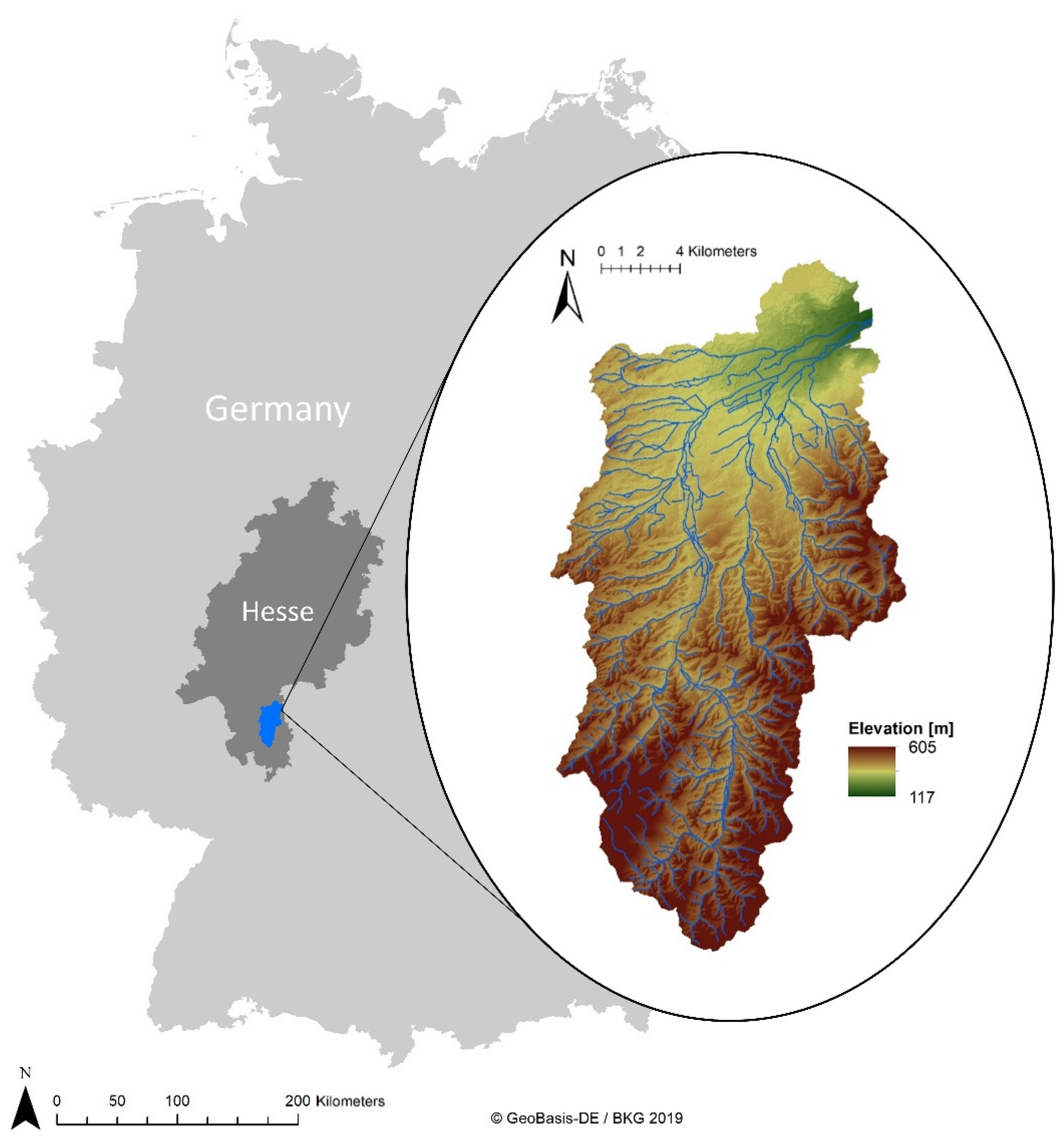
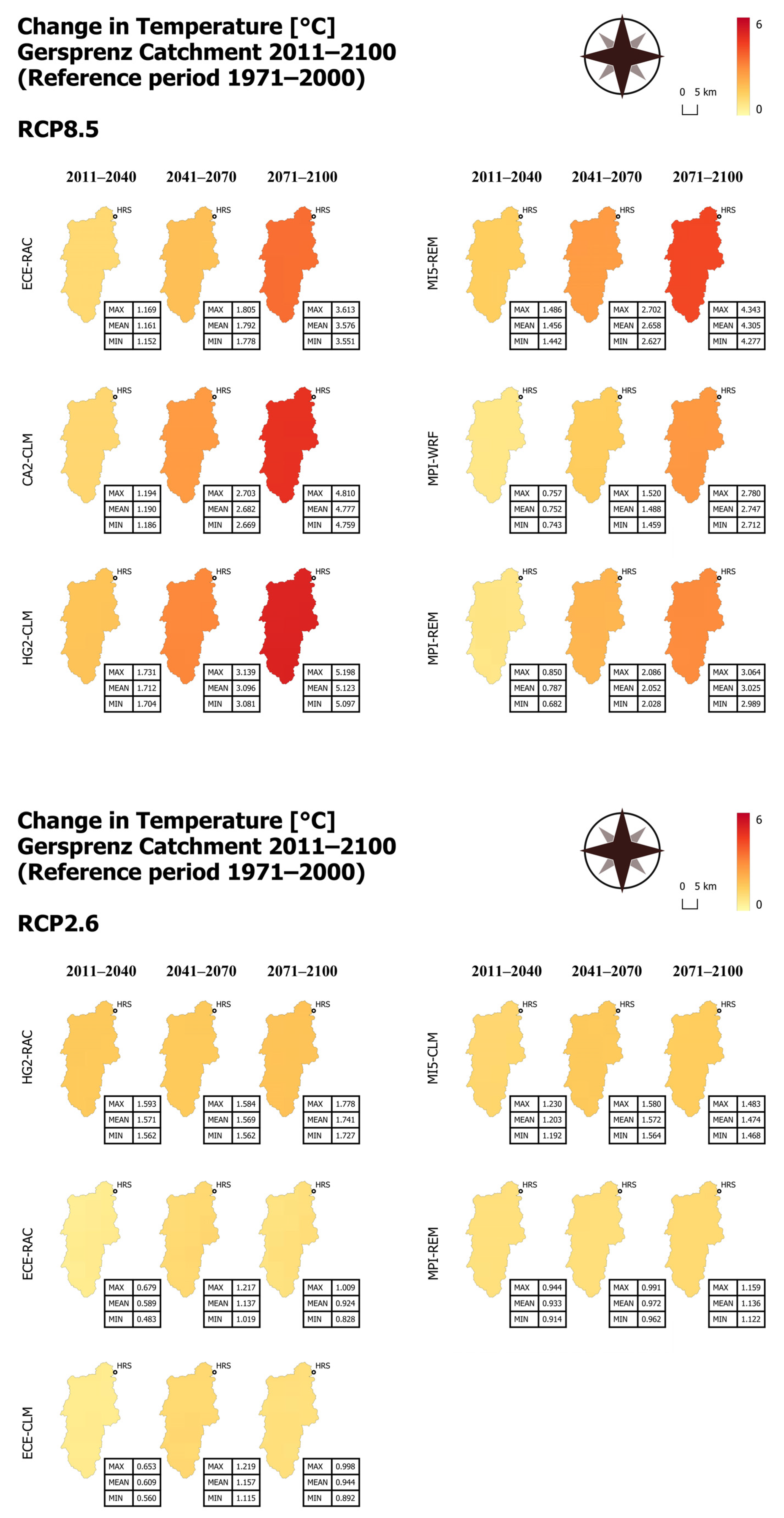
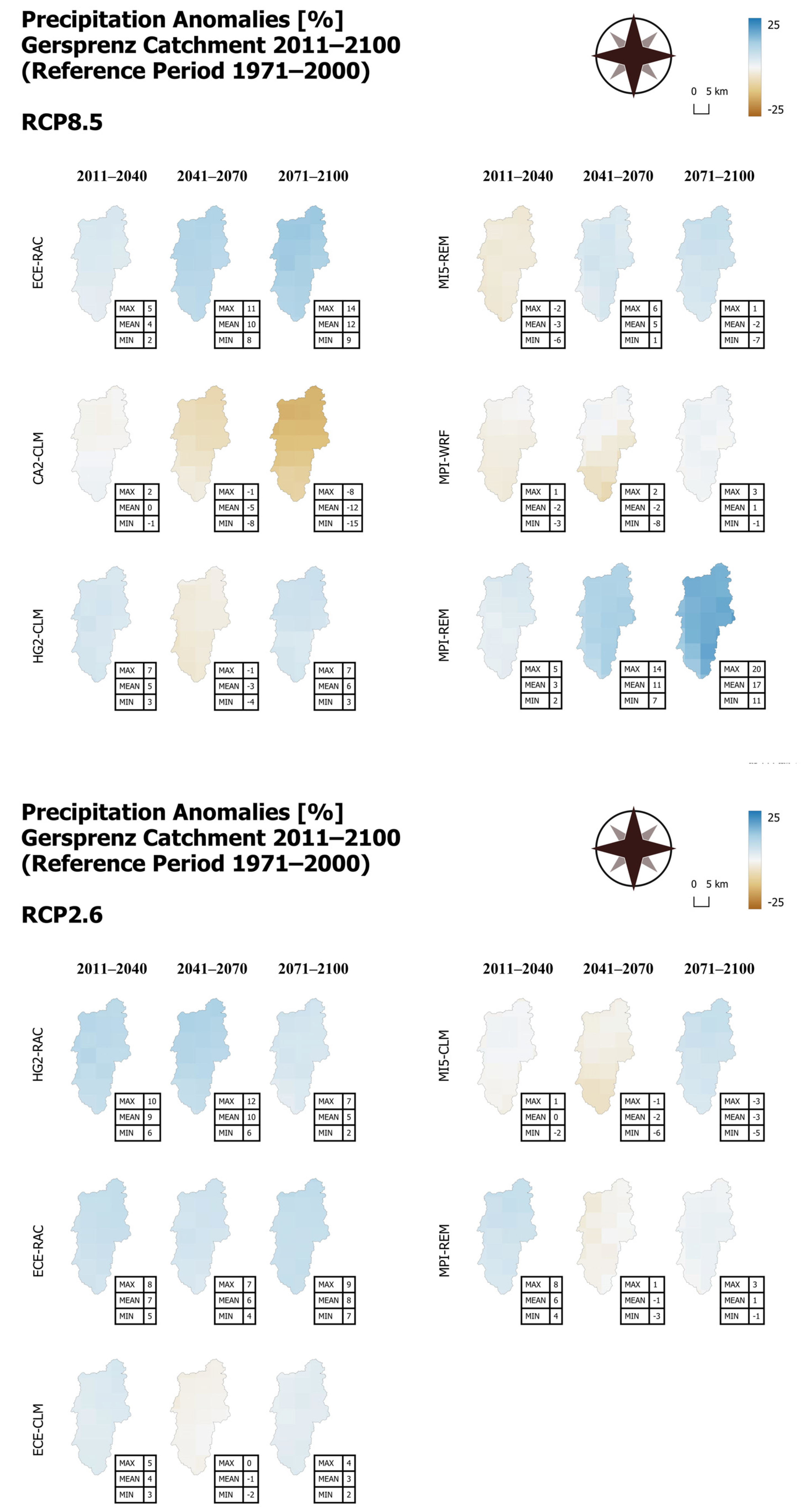
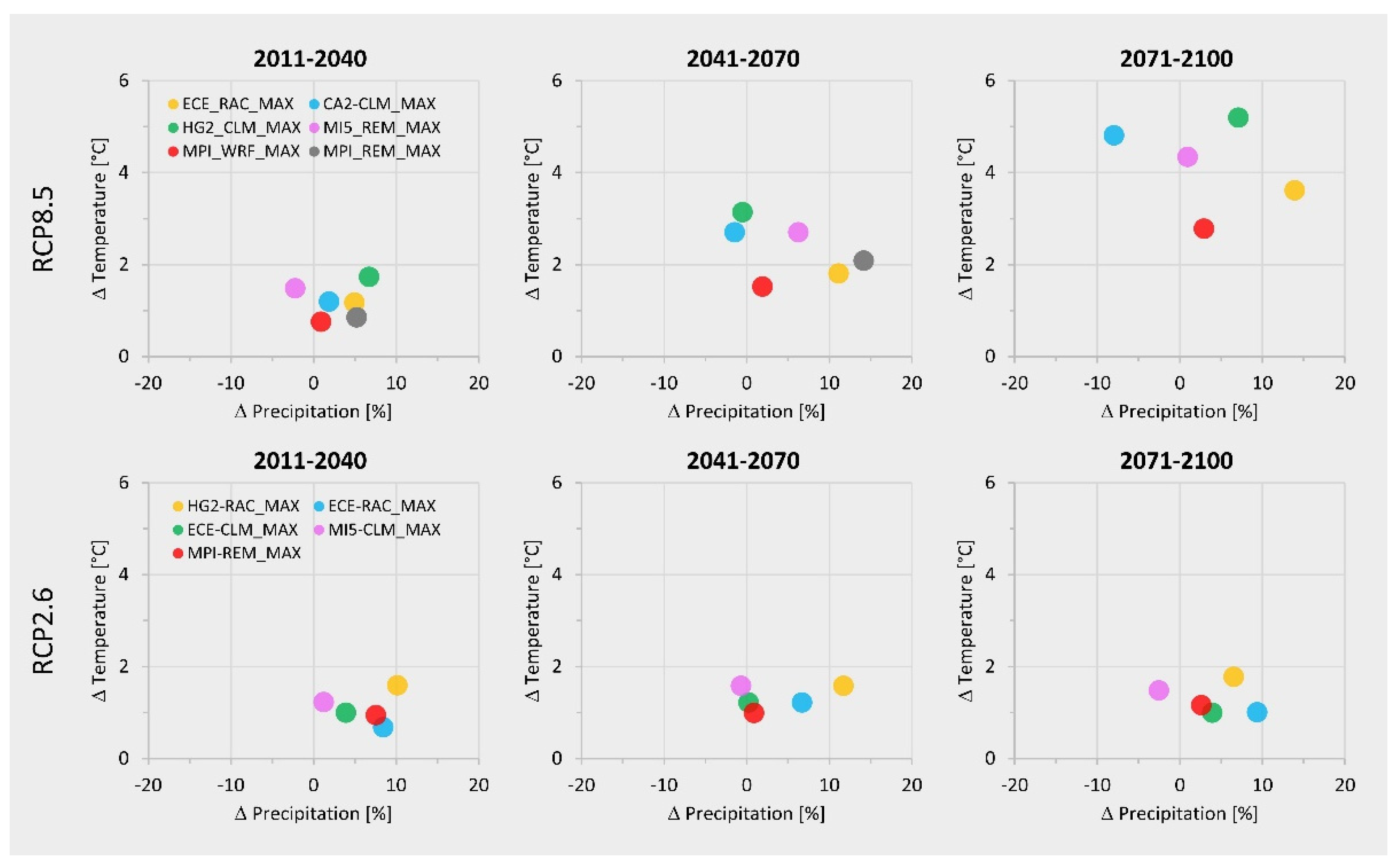


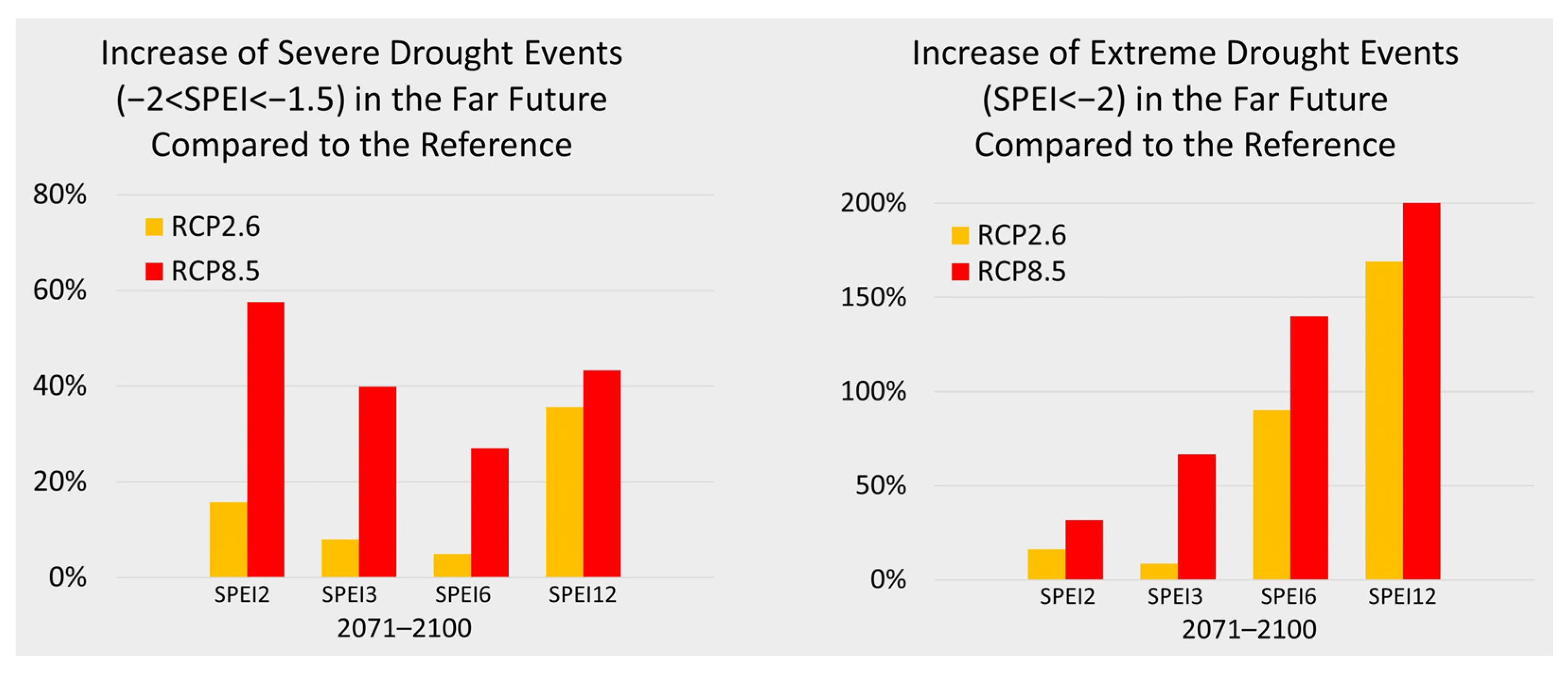
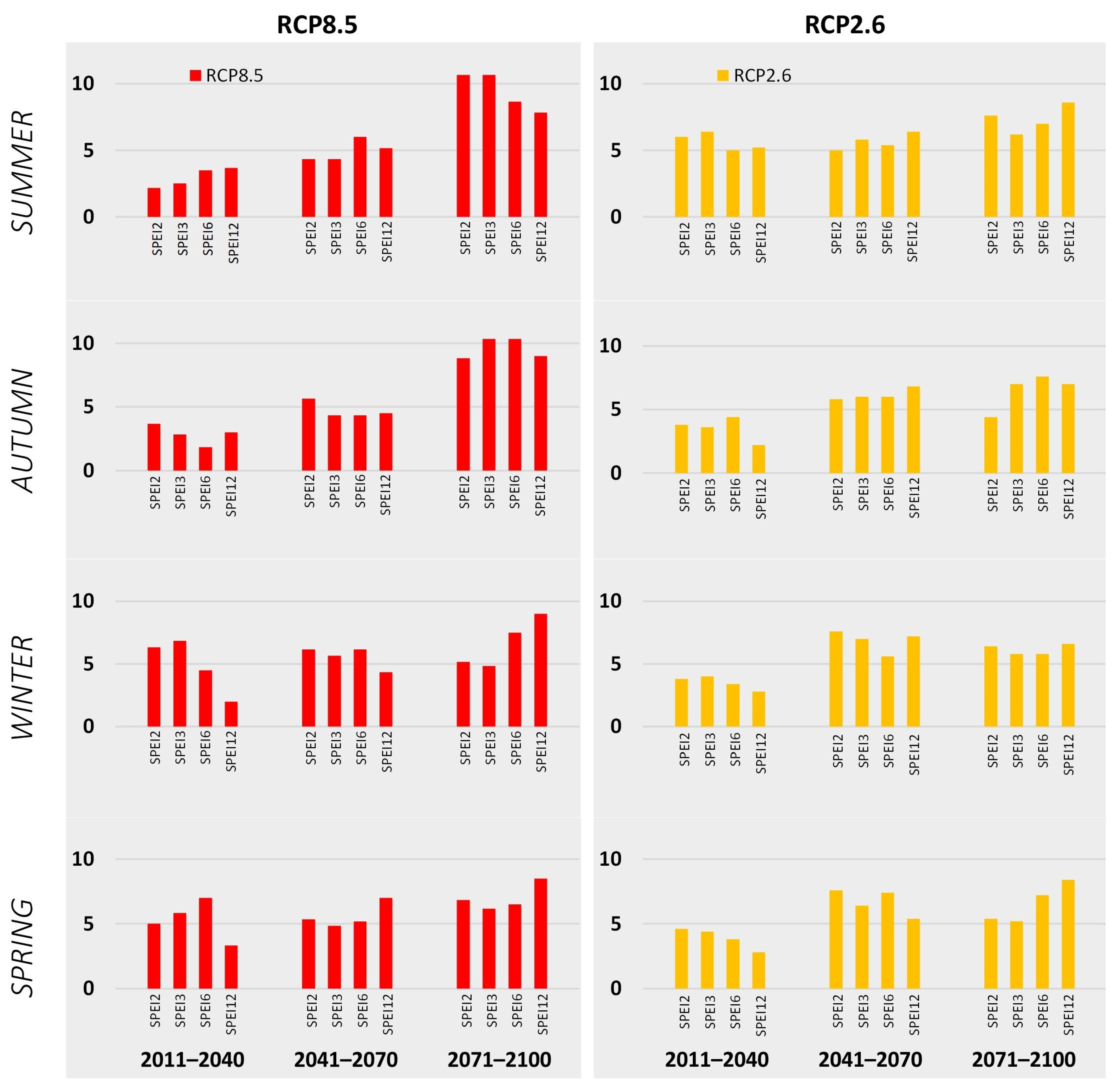
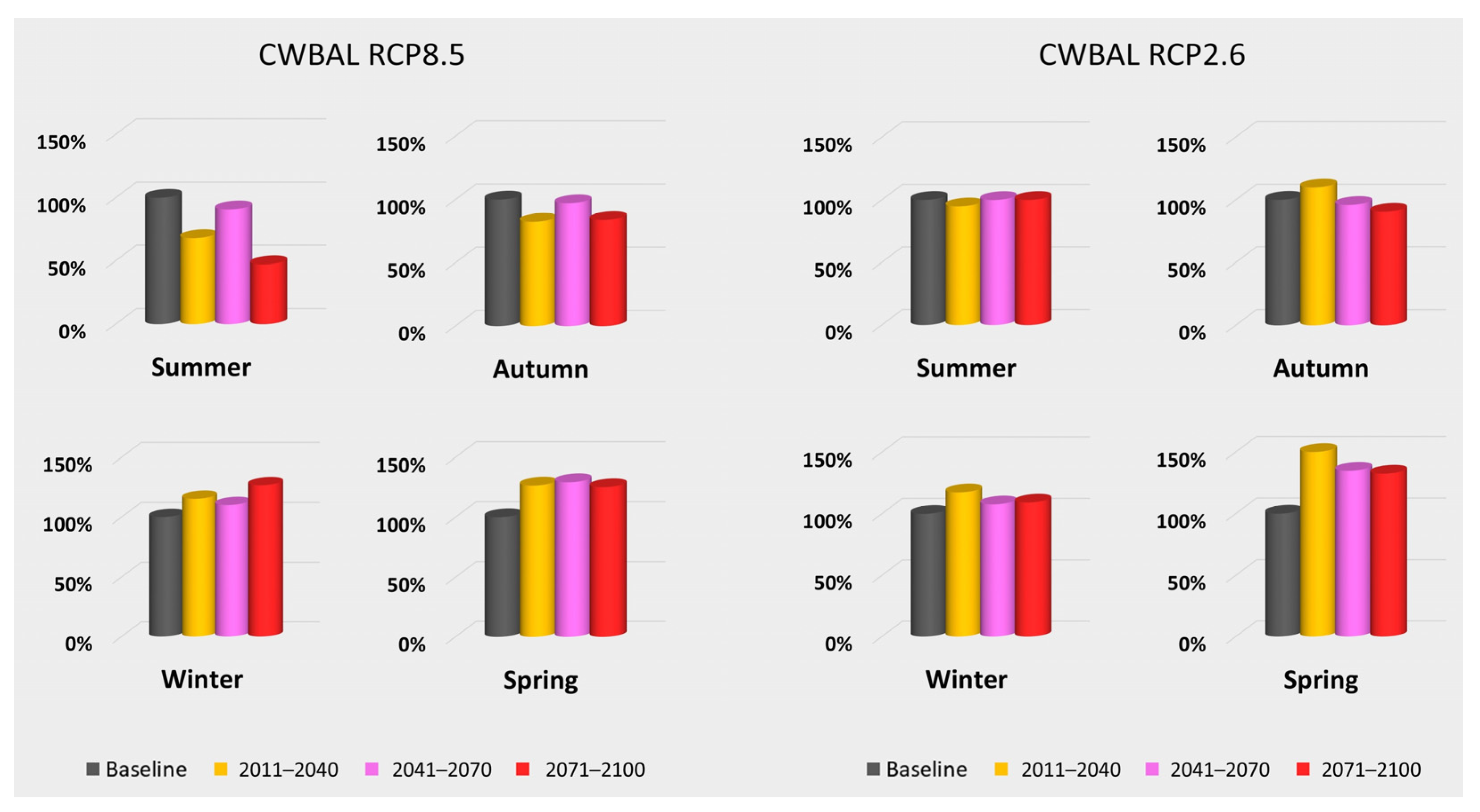
| RCP8.5 | RCP2.6 | ||||
|---|---|---|---|---|---|
| GCM | RCM | Abbreviation | GCM | RCM | Abbreviation |
| ICHEC-EC-EARTH (r1) | KNMI-RACMO22E | ECE-RAC | MOHC-HadGEM2-ES (r1) | KNMI-RACMO22E | HG2-RAC |
| CCCma-CanESM2 (r1) | CLMcom-CCLM4-8-17 | CA2-CLM | ICHEC-EC-EARTH (r12) | KNMI-RACMO22E | ECE-RAC |
| MOHC-HadGEM-ES (r1) | CLMcom-CCLM4-8-17 | HG2-CLM | ICHEC-EC-EARTH (r12) | CLMcom-CCLM4-8-17 | ECE-CLM |
| MIROC-MIROC5(r1) | GERICS-REMO2015 | MI5-REM | MIROC-MIROC5 (r1) | CLMcom-CCLM4-8-17 | MI5-CLM |
| MPI-M-MPI-ESM-LR (r1) | UHOH-WRF361H | MPI-WRF | MPI-M-MPI-ESM-LR (r2) | MPI-CSC-REMO2009 | MPI-REM |
| MPI-M-MPI-ESM-LR (r2) | MPI-CSC-REMO2009 | MPI-REM | |||
| PR | ||||||||||
|---|---|---|---|---|---|---|---|---|---|---|
| RCP8.5 | RCP2.6 | |||||||||
| Ind1 | Ind2 | Ind3 | Ind4 | Ind1 | Ind2 | Ind3 | Ind4 | |||
| ECE-RAC | 10 | 8 | 3 | 9 | HG2-RAC | 10 | 7 | 0 | 9 | |
| CA2-CLM | 10 | 4 | 0 | 9 | ECE-RAC | 10 | 8 | 7 | 9 | |
| HG2-CLM | 9 | 4 | 0 | 9 | ECE-CLM | 7 | 7 | 8 | 9 | |
| MI5-REM | 10 | 8 | 5 | 0 | MI5-CLM | 9 | 7 | 2 | 9 | |
| MPI-WRF | 5 | 5 | 3 | 7 | MPI-REM | 10 | 9 | 8 | 1 | |
| MPI-REM | 10 | 9 | 8 | 1 | ||||||
| TAS | ||||||||||
| RCP8.5 | RCP2.6 | |||||||||
| Ind1 | Ind2 | Ind3 | Ind4 | Ind1 | Ind2 | Ind3 | Ind4 | |||
| ECE-RAC | 1 | 1 | 10 | 5 | HG2-RAC | 5 | 4 | 7 | 6 | |
| CA2-CLM | 8 | 8 | 9 | 8 | ECE-RAC | 0 | 0 | 10 | 6 | |
| HG2-CLM | 10 | 7 | 7 | 8 | ECE-CLM | 5 | 5 | 10 | 8 | |
| MI5-REM | 9 | 5 | 5 | 9 | MI5-CLM | 7 | 5 | 6 | 8 | |
| MPI-WRF | 8 | 8 | 10 | 8 | MPI-REM | 9 | 8 | 10 | 8 | |
| MPI-REM | 9 | 8 | 10 | 8 | ||||||
Disclaimer/Publisher’s Note: The statements, opinions and data contained in all publications are solely those of the individual author(s) and contributor(s) and not of MDPI and/or the editor(s). MDPI and/or the editor(s) disclaim responsibility for any injury to people or property resulting from any ideas, methods, instructions or products referred to in the content. |
© 2023 by the authors. Licensee MDPI, Basel, Switzerland. This article is an open access article distributed under the terms and conditions of the Creative Commons Attribution (CC BY) license (https://creativecommons.org/licenses/by/4.0/).
Share and Cite
Grosser, P.F.; Schmalz, B. Projecting Hydroclimatic Extremes: Climate Change Impacts on Drought in a German Low Mountain Range Catchment. Atmosphere 2023, 14, 1203. https://doi.org/10.3390/atmos14081203
Grosser PF, Schmalz B. Projecting Hydroclimatic Extremes: Climate Change Impacts on Drought in a German Low Mountain Range Catchment. Atmosphere. 2023; 14(8):1203. https://doi.org/10.3390/atmos14081203
Chicago/Turabian StyleGrosser, Paula Farina, and Britta Schmalz. 2023. "Projecting Hydroclimatic Extremes: Climate Change Impacts on Drought in a German Low Mountain Range Catchment" Atmosphere 14, no. 8: 1203. https://doi.org/10.3390/atmos14081203
APA StyleGrosser, P. F., & Schmalz, B. (2023). Projecting Hydroclimatic Extremes: Climate Change Impacts on Drought in a German Low Mountain Range Catchment. Atmosphere, 14(8), 1203. https://doi.org/10.3390/atmos14081203









